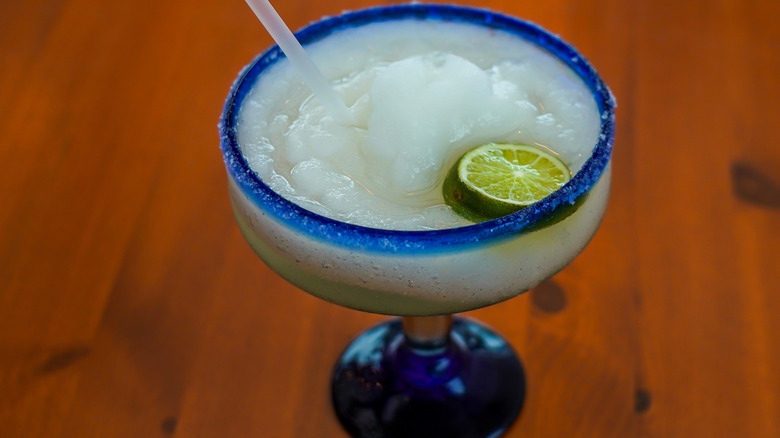How The Frozen Margarita Machine Changed Tex-Mex Restaurants Forever
Drinks and food go hand in hand — there's a reason for iconic combos like wine and cheese or burgers and beer. And oftentimes, there's a cultural note to the designated pairing, with diners preferring a regional favorite. So, say you step foot into a Tex-Mex restaurant, then there's a strong likelihood a frozen margarita will be available.
The drink's just as essential to the cuisine as chips, salsa, and a plate of enchiladas covered in cheese. Yet, its frequent appearance in restaurants is relatively young. The first frozen margarita machine was only created in the early '70s, by savvy restaurant owner Mariano Martinez. Aiming to craft a newfound consistency and reduce bartender labor, he repurposed an ice cream machine to pour out the frozen delight. Initial skepticism dissipated when the drink quickly caught on, offering a new take on the already established blender frozen margarita technique. The frozen margarita became an iconic drink of Dallas, and spread across Texas and beyond. Today, Martinez's innovation is even honored at the Smithsonian's National Museum of American History, evincing the cocktail's impact on culture.
The frozen margarita machine promoted Texan cuisine
Mariano Martinez's distinct drink is symbolic of Tex-Mex's bicultural influences. The restaurant environs, food flavors, and sensations surrounding the tequila tipple invoke associations of Mexico. However, such a cocktail never actually existed in the neighboring country, and rather emerged solely as a Dallas-born innovation with a Mexican influence. Throw in that even the shaken margarita boasts debated origin theories on both sides of the border, and the mixed heritage is evident.
Rather, the cocktail showcases the difference between Tex-Mex and Mexican-American food. The timing of the frozen margarita invention went hand in hand with the popularization of the Texan cuisine. With alcohol's strong influence on food culture, it's plausible Martinez's innovation itself strongly boosted the cuisine's marketability. Diners were drawn in to try the drink, and accordingly feasted — and appreciated — Tex-Mex fare. And so, a food category previously deemed as "inauthentic" by influential writers like Diane Kennedy, strengthened into its own respected food style. Since then, the evolution hasn't stopped: Mixologists top margaritas with red wine floats, employ mezcal, or can the margarita for a new era of convenience. Simultaneously, chefs craft new bicultural dishes, as well as pay respect to Texan Mexican foods that predate Tex-Mex. And so, the intersections keep molding a new culinary culture.

